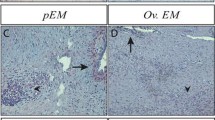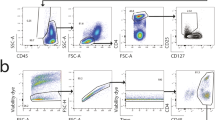Abstract
Mounting evidence suggests that immunological responses may be altered in endometriosis. The baboon (Papio anubis) is generally considered the best model of endometriosis pathogenesis. The objective of the current study was to investigate for the first time immunological changes within uterine and peritoneal draining lymph nodes in a nonhuman primate baboon model of endometriosis. Paraffin-embedded femoral lymph nodes were obtained from 22 normally cycling female baboons (induced endometriosis n = 11; control n = 11). Immunohistochemical staining was performed with antibodies for endometrial stromal cells, T cells, immature and mature dendritic cells, and B cells. Lymph nodes were evaluated using an automated cellular imaging system. Endometrial stromal cells were significantly increased in lymph nodes from animals with induced endometriosis, compared to control animals (P = .033). In animals with induced endometriosis, some lymph node immune cell populations including T cells, dendritic cells and B cells were increased, suggesting an efficient early response or peritoneal drainage.
Similar content being viewed by others
References
Vinatier D, Cosson M, Dufour P. Is endometriosis an endometrial disease? Eur J Obstet Gynecol Reprod Biol. 2000;91(2):113–125.
Halban J. Hysteroadenosis metastatica. Wien klin Woschensch. 1924;37:1205–1206.
Sampson J. Metastatic or embolic endometriosis, due to the menstrual dissemination of endometrial tissue into the venous circulation. Am J Pathol. 1927;3(2):93–109.
Javert CT. Pathogenesis of endometriosis based on endometrial homeoplasia, direct extension, exfoliation and implantation, lymphatic and hematogenous metastasis. Cancer. 1949;2(3): 399–410.
Ota H, Igarashi S, Tanaka T. Expression of γδ T cells and adhesion molecules in endometriotic tissue in patients with endometriosis and adenomyosis. Am J Reprod Immunol. 1996;35(5):477–482.
Bulmer JN, Jones RK, Searle RF. Intraepithelial leukocytes in endometriosis and adenomyosis: Comparison of eutopic and ectopic endometrium with normal endometrium. Hum Reprod. 1998;13(10):2910–2915.
Akoum A, Metz CN, Al-Akoum M, Kats R. Macrophage migration inhibitory factor expression in the intrauterine endometrium of women with endometriosis varies with disease stage, infertility status, and pelvic pain. Fertil Steril. 2006;85(5):1379–1385.
Al-Jefout M, Tokushige N, Hey-Cunningham AJ, et al. Micro-anatomy and function of the eutopic endometrium in women with endometriosis. Expert Rev Obstet Gynecol. 2009;4(1): 61–79.
Berbic M, Schulke L, Markham R, Tokushige N, Russell P, Fraser IS. Macrophage expression in endometrium of women with and without endometriosis. Hum Reprod. 2009;24(2): 325–332.
Schulke L, Berbic M, Manconi F, Tokushige N, Markham R, Fraser IS. Dendritic cell populations in the eutopic and ectopic endometrium of women with endometriosis. Hum Reprod. 2009;24(7):1695–1703.
Berbic M, Hey-Cunningham AJ, Ng C, et al. The role of FoxP3+ regulatory T-cells in endometriosis: A potential controlling mechanism for a complex, chronic immunological condition. Hum Reprod. 2010;25(4):900–907.
Beliard A, Donnez J, Nisolle M, Foidart JM. Localization of laminin, fibronectin, e-cadherin, and integrins in endometrium and endometriosis. Fertil Steril. 1997;67(2):266–272.
Donnez J, Smoes P, Gillerot S, Casanas-Roux F, Nisolle M. Vascular endothelial growth factor (VEGF) in endometriosis. Hum Reprod. 1998;13(6):1686–1690.
Vinatier D, Orazi G, Cosson M, et al. Theories of endometriosis. Eur J Obstet Gynecol Reprod Biol. 2001;96(1):21–34.
Hull ML, Charnock-Jones DS, Chan CLK, et al. Antiangiogenic agents are effective inhibitors of endometriosis. J Clin Endocrinol Metab. 2003;88(6):2889–2899.
Sampson JA. Intestinal adenomas of endometrial type: Their importance and their relation to ovarian hematomas of endometrial type (perforating hemorrhagic cysts of the ovary). Arch Surg. 1922;5(1):217–280.
Irani S, Atkinson L, Cabaniss C, Danovitch SH. Pleuroperitoneal endometriosis. Obstet Gynecol. 1976;47(Suppl. 1):72–74.
Roesner N, Boeger A. Endometriosis of the ureter. Eur Urol. 1979;5(1):294–297.
Mascaretti G, Patacchiola F, Di Berardino C, Moscarini M. Isolated inguinal endometriosis. A clinical case. Minerva Ginecol. 2000;52(6):249–252.
Abrao MS, Podgaec S, Dias Jr JA, et al. Deeply infiltrating endometriosis affecting the rectum and lymph nodes. Fertil Steril. 2006;86(3):543–547.
Mechsner S, Weichbrodt M, Riedlinger WFJ, et al. Estrogen and progestogen receptor positive endometriotic lesions and disseminated cells in pelvic sentinel lymph nodes of patients with deep infiltrating rectovaginal endometriosis: A pilot study. Hum Reprod. 2008;23(10):2202–2209.
Noel JC, Chapron C, Fayt I, Anaf V. Lymph node involvement and lymphovascular invasion in deep infiltrating rectosigmoid endometriosis. Fertil Steril. 2008;89(5):1069–1072.
Berbic M, Hey-Cunningham AJ, Ng C, et al. A novel study of endometrial stromal cells and immune-cell populations in sentinel uterine-draining lymph nodes during the menstrual cycle and in endometriosis. J Reprod Immunol. 2011 in submission.
Gashaw I, Hastings JM, Jackson KS, Winterhager E, Fazleabas AT. Induced endometriosis in the baboon (Papio anubis) increases the expression of the proangiogenic factor CYR61 (CCN1) in eutopic and ectopic endometria. Biol Reprod. 2006;74(6):1060–1066.
Hastings JM, Fazleabas AT. A baboon model for endometriosis: Implications for fertility. Reprod Biol Endocrinol. 2006;4(Suppl. 1): article number S7.
Hastings JM, Jackson KS, Mavrogianis PA, Fazleabas AT. The estrogen early response gene FOS is altered in a baboon model of endometriosis. Biol Reprod. 2006;75(2):176–182.
Ellis H. Anatomy of the uterus. Anaesth Intensive Care. 2008;9(2):107–109.
Grevious MA, Cohen M, Shah SR, Rodriguez P. Structural and functional anatomy of the abdominal wall. Clin Plast Surg. 2006;33(2):169–179.
Fazleabas AT, Brudney A, Gurates B, Chai D, Bulun S. A modified baboon model for endometriosis. Ann NY Acad Sci. 2002;955:308–317.
Becker, S, Becker-Pergola, G, Fehm, T, et al. Image analysis systems for the detection of disseminated breast cancer cells on bone-marrow cytospins. J Clin Lab Anal 2005; 19(3): 115–119.
Descazeaud, A, De La Taille, A, Allory, Y, et al. Characterization of ZAG protein expression in prostate cancer using a semi-automated microscope system. 2006; 66(10):1037–1043.
Tawfik OW, Kimler BF, Davis M, et al. Comparison of immunohistochemistry by automated cellular imaging system (ACIS) versus fluorescence in-situ hybridization in the evaluation of HER-2/neu expression in primary breast carcinoma. Histopathology. 2006;48(3):258–267.
McKay JS, Bigley A, Bell A, et al. A pilot evaluation of the use of tissue microarrays for quantitation of target distribution in drug discovery pathology. Exp Toxicol Pathol. 2006;57(3):181–193.
Le Gouill S, Talmant P, Touzeau C, et al. The clinical presentation and prognosis of diffuse large B-cell lymphoma with t(14;18) and 8q24/c-myc rearrangement. Haematologica. 2007;92(10):1335–1342.
Eskenazi B, Warner ML. Epidemiology of endometriosis. Obstet Gynecol Clin North Am. 1997;24(2):235–258.
Hadfield R, Mardon H, Barlow D, Kennedy S. Delay in the diagnosis of endometriosis: A survey of women from the USA and the UK. Hum Reprod. 1996;11(4):878–880.
Ballard K, Lowton K, Wright J. What’s the delay? A qualitative study of women’s experiences of reaching a diagnosis of endometriosis. Fertil Steril. 2006;86(5):1296–1301.
D’Hooghe TM, Bambra CS, Raeymaekers BM, Hill JA. Pelvic inflammation induced by diagnostic laparoscopy in baboons. Fertil Steril. 1999;72(6):1134–1141.
D’Hooghe TM, Bambra CS, Xiao L, Peixe K, Hill JA. Effect of menstruation and intrapelvic injection of endometrium on inflammatory parameters of peritoneal fluid in the baboon (Papio anubis and Papio cynocephalus). Am J Obstet Gynecol. 2001;184(5):917–925.
D’Hooghe TM, Hill JA, Oosterlynck DJ, Koninckx PR, Bambra CS. Effect of endometriosis on white blood cell subpopulations in peripheral blood and peritoneal fluid of baboons. Hum Reprod. 1996;11(8):1736–1740.
Author information
Authors and Affiliations
Corresponding author
Rights and permissions
About this article
Cite this article
Hey-Cunningham, A.J., Fazleabas, A.T., Braundmeier, A.G. et al. Endometrial Stromal Cells and Immune Cell Populations Within Lymph Nodes in a Nonhuman Primate Model of Endometriosis. Reprod. Sci. 18, 747–754 (2011). https://doi.org/10.1177/1933719110397210
Published:
Issue Date:
DOI: https://doi.org/10.1177/1933719110397210




